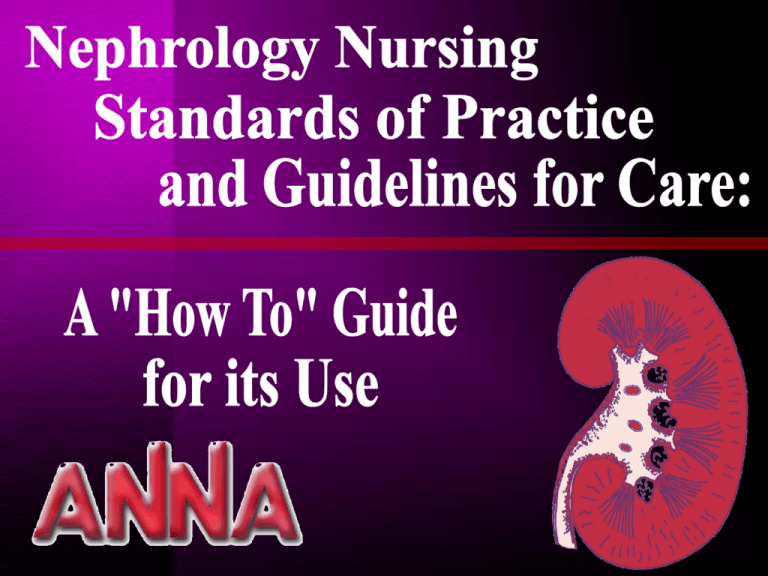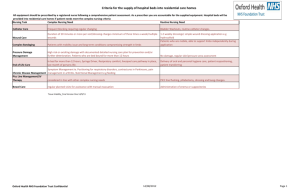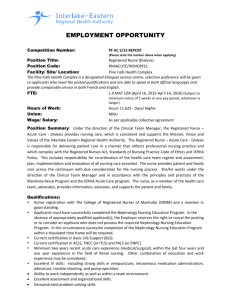Nephrology Nursing Standards of Practice: Ideal or
advertisement

Co-editors Sally Burrows-Hudson MS, RN, CNN Barbara Prowant MS, RN, CNN Objectives • Define standards of practice. • Discuss the application of standards of care within nephrology nursing practice. • Identify barriers to the implementation of professional performance standards. • Compare and contrast nursing care guidelines with standards of practice. Who has Standards of Practice? Realtors Marketing Message Therapists Polygraph Technicians Rehab engineers and assistive technology Water proofing and structural repair Music therapy Exercise physiologists Educators in English studies Special education personnel Home inspectors Art conservators Google, 2005 Dental Hygienists Mediators Financial Planners Occupational Therapy Pharmacists Child care providers Lawyers Insurance personnel Investment advisors Nurses What are these people trying to do? Why? 1. Protect those for whom they provide services. 2. Set expectations for performance. 3. Hold their professionals responsible. Begin with a definition Definition of Nursing “Nursing is the • protection, promotion, and optimization of health and abilities, • prevention of illness and injury, • alleviation of suffering through the diagnosis and treatment of human response, and • advocacy in the care of individuals, families, communities, and populations.” Nursing’s Social Policy Statement, 2003 It’s not enough to define nursing. We are obligated to describe to the public the responsibilities for which we are accountable. Standards • Goal is to improve the health and well-being of all individuals, communities, and populations through significant and visible contributions of registered nurses utilizing standards-based practice. • Function is to define the nursing profession’s accountability to the public and the outcomes for which registered nurses are responsible. • Describes a competent level of nursing practice and professional performance common to all registered nurses. Competent level of nursing practice and professional performance Common to all nurses regardless of: – – – – – – educational preparation type of practice patient population practice setting years of experience title; position Standards of Nursing Practice Standards of Practice 1. 2. 3. 4. 5. Assessment Diagnosis Outcomes Identification Planning Implementation a. Coordination of Care b. Health Teaching and Health Promotion c. Consultation (APN) d. Prescriptive Authority (APN) 6. Evaluation Standards of Professional Performance 7. Quality of Practice 8. Education 9. Professional Practice Evaluation 10. Collegiality 11. Collaboration 12. Ethics 13. Research 14. Resource Utilization 15. Leadership Who decides? Nurses! It all starts with us! • ANA takes the lead – works with their own councils and committees; seeks input and acknowledgement from specialty nursing organizations; publishes and disseminates. • ANNA reviews, adopts, and disseminates to nephrology nurses and nephrology community (since 1991) SOCIETY Professional Regulation Legal Regulation The profession’s definition of the nature and scope of practice State Nursing Practice Acts Professional Standards of Practice Professional Standards of educational outcomes for nursing education programs State Board of Nursing Rules and Regulations Professional standards, goals, policies, procedures, protocols for nursing service organizations Accreditation of educational programs Certification of individuals in general and specialty practice Quality Improvement Accreditation of organized nursing services Client Licensure for Practice Public Protection American Nephrology Nurses’ Association 1977: Standards of Clinical Practice 1982: Nephrology Nursing Standards of Clinical practice 1988: ANNA Standards of Clinical Practice for Nephrology Nursing 1993: Standards of Clinical Practice for Nephrology Nursing 1999: Standards and Guidelines of Clinical Practice for Nephrology Nursing 2005: Nephrology Nursing Standards of Practice and Guidelines for Care Standards of Practice Guidelines for Care Universal Guidelines NEW! CRRT endorsed by AACN Nephrology Nursing Standards of Practice Standards of Practice describe a competent level of nursing care Standards of Practice 1. 2. 3. 4. 5. Assessment Diagnosis Outcomes Identification Planning Implementation a. Coordination of Care b. Health Teaching and Health Promotion c. Consultation (APN) d. Prescriptive Authority (APN) 6. Evaluation Format Standard Title Standard statement Measurement criteria Nephrology nurse Advanced practice nephrology nurse and Nephrology nursing role specialty Standard title & statement Measurement Criteria Measurement criteria for the APN Examples Standard of Practice 5: Implementation The nephrology registered nurse implements the identified plan. Measurement Criteria: • Implements the plan in a safe and timely manner. • Uses evidence-based interventions and treatments specific to the diagnosis or problem. • Uses community resources and systems to implement the plan. • Collaborates with nursing colleagues and others to implement the plan. • Documents implementation and any modification. Standard of Practice 5b: Health Teaching and Health Promotion The nephrology registered nurse employs strategies to promote health and a safe environment. Measurement Criteria: •Provides health teaching that addresses such topics as healthy lifestyles, risk-reducing behaviors, developmental needs, activities of daily living, and preventive self-care. Standards of Professional Performance Standards of Professional Performance describe a competent level of behavior in the professional role Standards of Professional Performance 7. Quality of Practice 8. Education 9. Professional Practice Evaluation 10. Collegiality 11. Collaboration 12. Ethics 13. Research 14. Resource Utilization 15. Leadership Examples Standard of Professional Performance 8: Education The nephrology registered nurse attains knowledge and competency that reflects current nursing practice. Measurement Criteria: • Participates in ongoing educational activities related to appropriate knowledge bases and professional issues. • Demonstrates a commitment to life-long learning through self-reflection and inquiry to identify learning needs. • Seeks experiences that reflect current practice in order to maintain skills and competence in clinical practice or performance. • Acquires knowledge and skills appropriate to the specialty area, practice setting, role, or situation. • Maintains professional records that provide evidence of competency and life-long learning. • Seeks experiences and formal and independent learning activities to maintain and develop clinical and professional skills and knowledge. • Uses current research findings and other evidence to expand knowledge, enhance role performance, and increase knowledge of professional issues. Standard of Professional Performance 10: Collegiality The nephrology registered nurse interacts with and contributes to the professional development of peers and colleagues. Measurement Criteria: • Shares knowledge and skills with peers and colleagues as evidenced by such activities as patient care conferences or presentations at formal or informal meetings. • Provides peers with feedback regarding their practice and/or role performance. • Interacts with peers and colleagues to enhance one’s own professional nursing practice and/or role performance. • Maintains compassionate and caring relationships with peers and colleagues. • Contributes to an environment that is conducive to the education of healthcare professionals. • Contributes to a supportive and healthy work environment. Standard of Professional Performance 15: Leadership The nephrology registered nurse provides leadership in the professional practice setting. Measurement Criteria: • Engages in teamwork as a team player and a team builder. • Works to create and maintain healthy work environments. • Teaches others to succeed by mentoring and other strategies. • Exhibits creativity and flexibility through times of change. • Demonstrates energy, excitement, and passion for quality work. • Directs the coordination of care across settings . . . • Willingly accepts mistakes by self and others . . . Nephrology Nursing Guidelines for Care Guidelines for Care Universal Guidelines NEW! CRRT endorsed by AACN Nephrology Nursing Guidelines for Care • Draw on existing clinical practice guidelines (CPG). - CPG are systematically developed statements that address the care of specific patient populations or phenomena and are based on the best available scientific evidence and/or expert opinion. Examples: K/DOQI, AHA, AHRQ Nephrology Nursing Guidelines for Care • Describe a process of patient care management that has the potential to improve nurse and patient decision making, and thereby, patient outcomes. Format Topic title Patient Outcome statements Nursing Care Assessment Intervention Patient Teaching Advanced Practice Nursing Care Assessment Intervention Patient Teaching Patient outcome statement Nursing Care - Assessment - Intervention - Patient Teaching How do Standards and Guidelines fit into my daily practice? STRUCTURE PROCESS STANDARDS OF PROFESSIONAL PERFORMANCE STANDARDS OF CLINICAL PRACTICE • Assessment • Quality of Care • Performance Appraisal • Education • Collegiality • Ethics • Diagnosis • Outcome Identification • Planning • Implementation OUTCOME PATIENT OUTCOMES • Clinical End Points • Safety • General Well-Being • Rehabilitation • Satisfaction with Care NURSE OUTCOMES • Evaluation • Collaboration • Research • Satisfaction CLINICAL PRACTICE GUIDELINES • Resource Utilization •Leadership • Safety • Professional Development • Retention CARE DELIVERY MODELS ADMINISTRATION SUPPORT • Philosophy & Practice ADVANCED PRACTICE • Leadership • Infrastructure • Communication PROCESS ENHANCEMENT QUALITY IMPROVEMENT RESEARCH Use of Standards and Guidelines • Quality Improvement systems • Policies, procedures, protocols • Position descriptions and performance appraisals • Educational programs; Staff training • Patient education • Outcome evaluation tools • Regulatory systems • Nephrology nursing research Assumptions 1. A link exists between the professional work environment and the registered nurse’s ability to practice. 2. Nursing practice is individualized. 3. Nurses establish partnerships. Work environment and ability to practice “Overall, in engaging in these assessments, I have always been left with the rational conclusion that we passed inspection, but with the visceral reaction that something vital has been missed or miscalculated in the inventory”. Anonymous Nursing practice is individualized Nurse Patient Individualization? Family Dialysis Chain Nurse Third Party Payer ESRD Networks Management Healthcare providers Regulations Patient Partnerships Horizontal Violence “Our communication is fraught with indirect aggression, bickering, and faultfinding. It is disheartening to experience the underhanded and devastating ways that nurses attack each other”. VonFrolio, 2005 Assumptions 1. A link exists between the professional work environment and the registered nurse’s ability to practice. “Employers must provide an environment that supports nursing practice and decision-making.” 2. Nursing practice is individualized. “ . . . with appropriate information to make informed decisions regarding health care and healthcare issues.” 3. Nurses establish partnerships. “The registered nurse establishes a partnership with the patient, family, support system, and other healthcare providers. The nurse works collaboratively to coordinate the care provided to the patient.” Standards and Guidelines Standards provide a broad framework for competency level practice. Guidelines address the process of care for specific populations or phenomena. STRUCTURE PROCESS OUTCOME STANDARDS OF PROFESSIONAL PERFORMANCE STANDARDS OF CLINICAL PRACTICE PATIENT OUTCOMES • Clinical End Points • Safety • General Well-Being • Assessment • Quality of Care • Performance Appraisal • Education • Collegiality • Ethics • Diagnosis • Outcome Identification • Rehabilitation • Satisfaction with Care • Planning • Implementation NURSE OUTCOMES • Satisfaction • Evaluation • Collaboration • Research • Safety • Professional Development CLINICAL PRACTICE GUIDELINES • Resource Utilization • Leadership • Retention CARE DELIVERY MODELS ADMINISTRATION SUPPORT • Philosophy & Practice ADVANCED PRACTICE • Leadership • Infrastructure • Communication PROCESS ENHANCEMENT QUALITY IMPROVEMENT RESEARCH Case Study Incorporating the ANNA Guidelines of Clinical Practice of Nephrology Nursing into PD Clinic Policies & Procedures First Page in Home PD P&P Manual • “The Home Dialysis Department has adapted pertinent segments of the ANNA standards as our guidelines for optimal care.” • Reference: Burrows-Hudson, S. (ed). ANNA Standards and Guidelines of Clinical Practice for Nephrology Nursing, Pitman, NJ: American Nephrology Nurses’ Association, 1999. Guidelines Selected for Inclusion in P&P Manual PD Specific - Process/Delivery of Care • Initial Evaluation • Patient Education • Ongoing Monitoring Guidelines Selected for Inclusion in P&P Manual PD Specific - Clinical • Peritonitis • Exit Site Leak • Loss of Catheter Integrity • Catheter Exit Site or Tunnel Infection • PD Catheter Placement – Pre-op Care • PD Catheter Placement – Post-op Care Guidelines Selected for Inclusion in P&P Manual Universal Nephrology Nursing - Clinical • Fluid Management • Bowel Function • Activity Guidelines Selected for Inclusion in P&P Manual Universal Nephrology Nursing Psychosocial • Self Concept • Coping • Family Process • Sexuality – Adult • Sexuality – Adolescent Guideline Sections Renamed Guideline PD P&P Book Catheter Integrity Loss of Catheter Integrity Dialysate Leak Exit Site Leak Activity & Rehabilitation Activity Examples of Revisions Self Concept • One new PD-specific intervention was added: – Encourage patient to look at and care for catheter. • One intervention was deleted: – Consult with physician/advanced practice nurse regarding need for psychiatric intervention. Examples of Revisions Sexuality – Adolescent One assessment was deleted: • Assess sexual development using Tanner staging. Examples of Revisions Fluid Management – Assessments omitted • Apical and peripheral pulses • Heart sounds • Respiratory rate and quality • Breath sounds • Neck vein distension, jugular venous pressure • Residual renal function • Sodium intake • Laboratory Results • Skin turgor and mucous membranes • Extravasation of fluids • Assess patient’s knowledge of fluid quantification Examples of Revisions Fluid Management – Assessment • Weight • Blood pressure • Temperature • Presence of edema • Intake and output • Medication regimen • Appetite • Diarrhea • Nausea, vomiting • SOB, coughing • Dizziness • Muscle cramping Examples of Revisions Fluid Management – Interventions deleted • Determine UF for each treatment • Monitor patient’s response to UF or diuretics • Adjust UF or diuretics • Administer fluids Examples of Revisions Fluid Management – Interventions retained • Collaborate with MD & RD in planning fluid intake and medication prescription. • Encourage fluid and dietary management according to prescription. • Identify resources to assist patient to achieve goals of fluid management. • Initiate consults as needed. Examples of Revisions Fluid Management – New Intervention added: • Assist the home patient in acquiring necessary supplies as dialysis prescription changes. Sample Guideline Loss of Catheter Integrity – Assessment Guidelines P&P Book Assess catheter per recommended protocol. Assess catheter integrity daily. Inspect connections between the catheter, catheter adapter and extension tubing, when present. Inspect connections between the catheter, titanium adapter and extension tubing or transfer set. Sample Guideline Loss of Catheter Integrity – Intervention Guidelines If a break or hole in the catheter or extension tubing or loose connection is noted: •Clamp above break, tear or separation •Cover with sterile dressing or barrier •Notify the physician •Obtain a sample of peritoneal effluent •Cut, repair or extent catheter, if possible •Replace catheter connection •Replace the tubing and/or catheter adapter according to standard protocol •Initiate antibiotic therapy as ordered •Observe for signs and symptoms of peritonitis •Replace the tubing and/or catheter adapter P&P Book If a break or hole in the catheter is noted: •Notify the physician •Repair the catheter, if possible •Initiate antibiotic therapy as ordered Sample Guideline Loss of Catheter Integrity – Intervention Guidelines P&P Book If unable to repair catheter: •D/C peritoneal dialysis. •Prepare the patient for catheter removal and/or replacement. If unable to repair catheter: •D/C peritoneal dialysis. •Prepare the patient for catheter removal and/or replacement. Reevaluate connect disconnect and dressing change techniques. If a leak in the extension tubing or a loose connection is noted: •Replacing the tubing and titanium adapter as needed per protocol. •Initiate antibiotic therapy as ordered. Summary • Appropriate guidelines were selected • Each section was adapted to fit the program • Most sections were simplified • Content was added – Specific to home dialysis – Specific to PD • The guidelines are used in conjunction with unit Policies & Procedures Mission Statement ANNA will advance nephrology nursing practice and positively influence outcomes for patients with kidney or other disease processes requiring replacement therapies through advocacy, scholarship, and excellence. To purchase ANNA’s Standards of Practice go to www.annanurse.org Member Price - $40 Non-Member Price - $60






